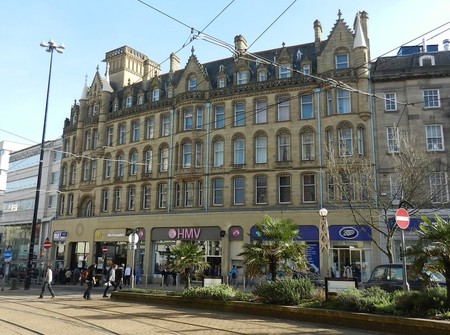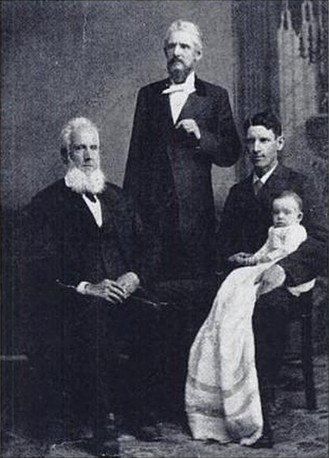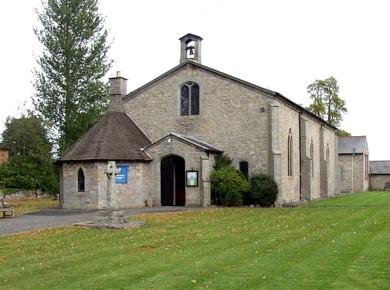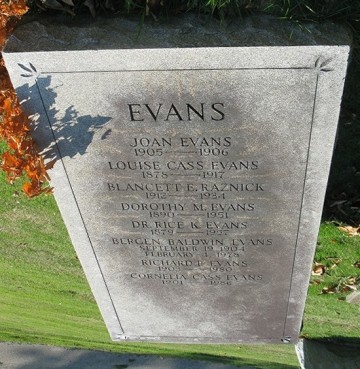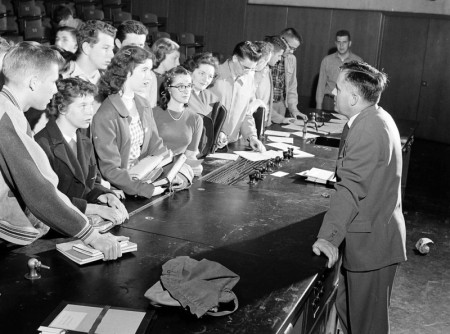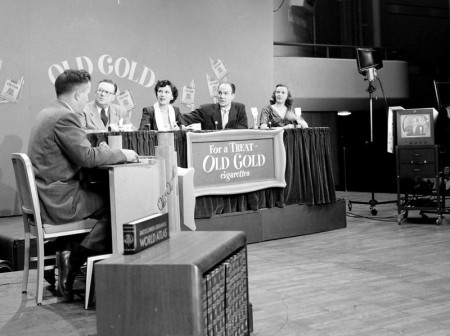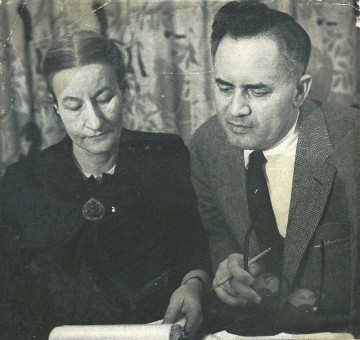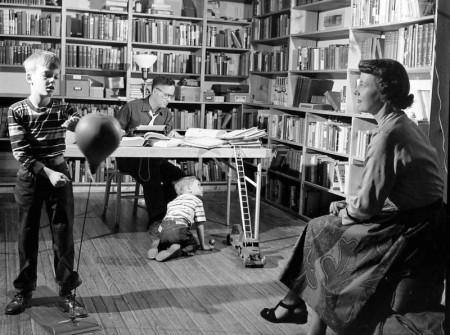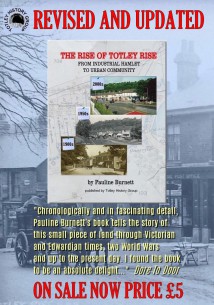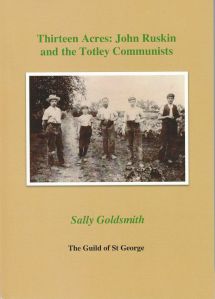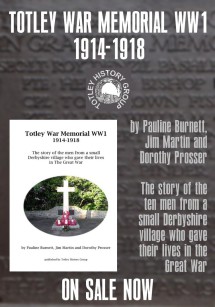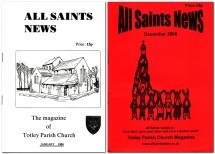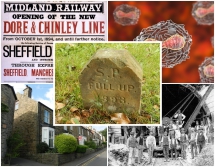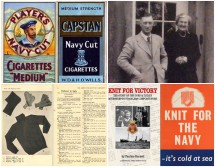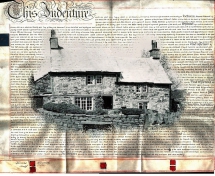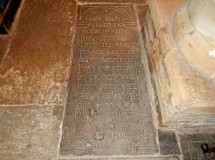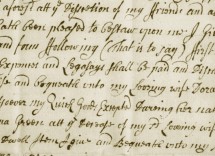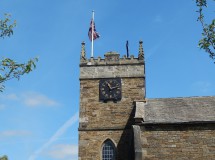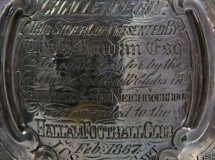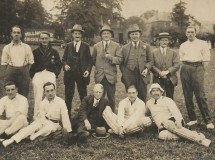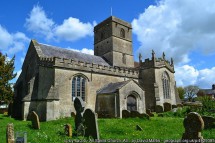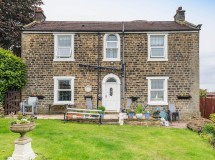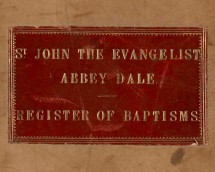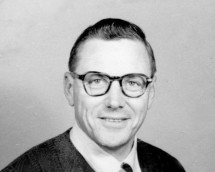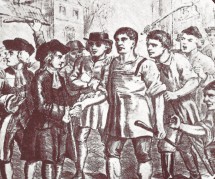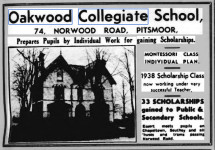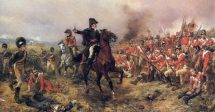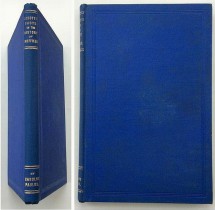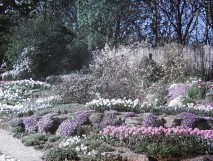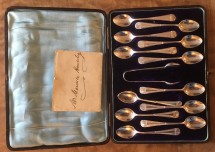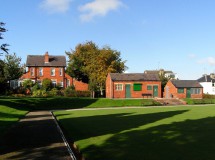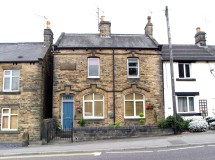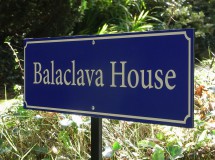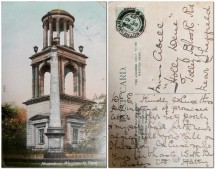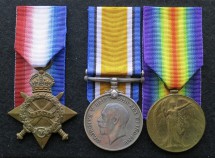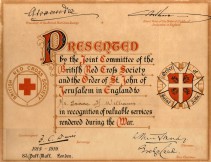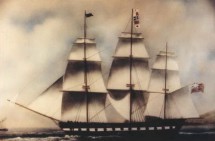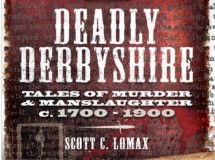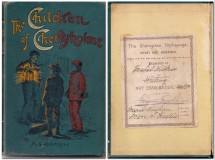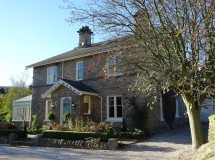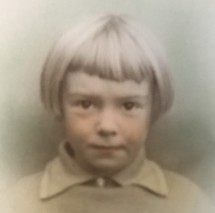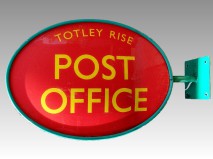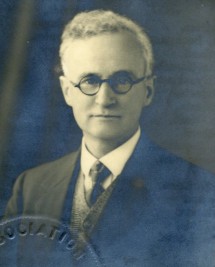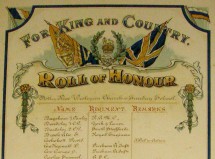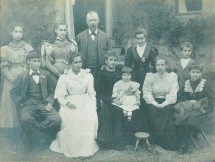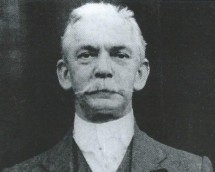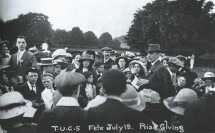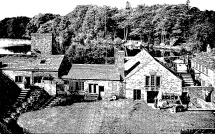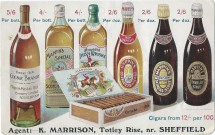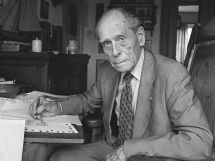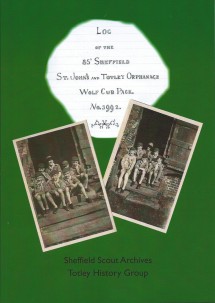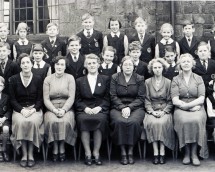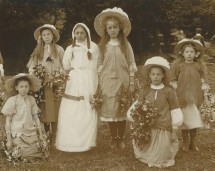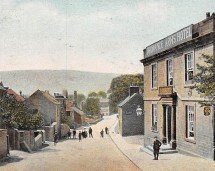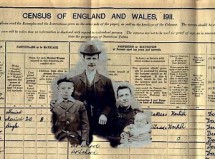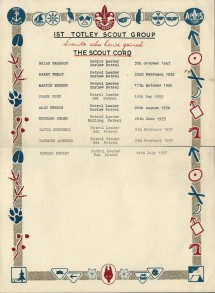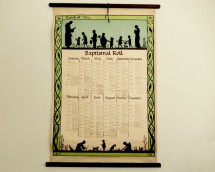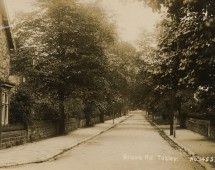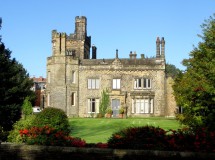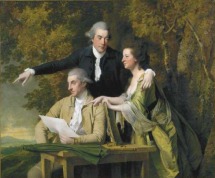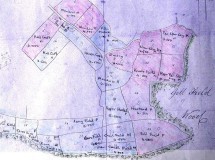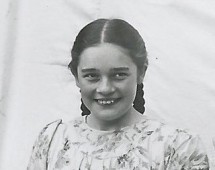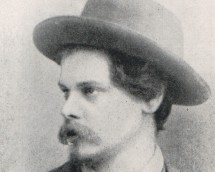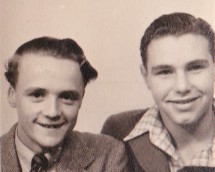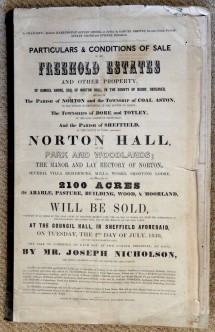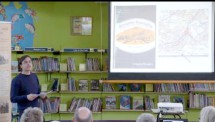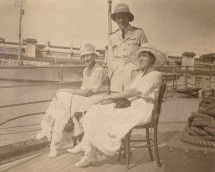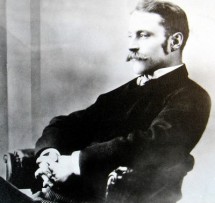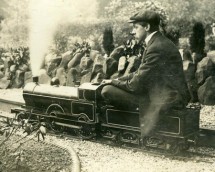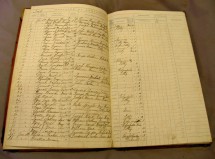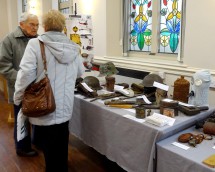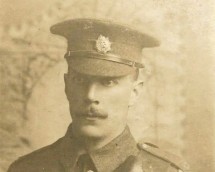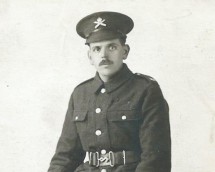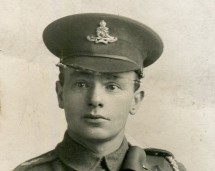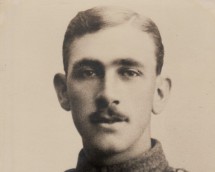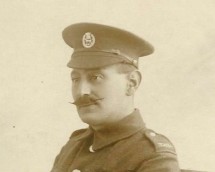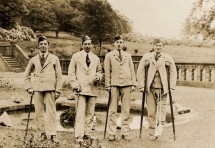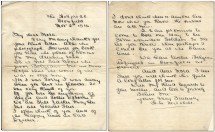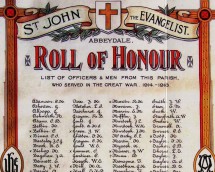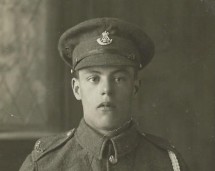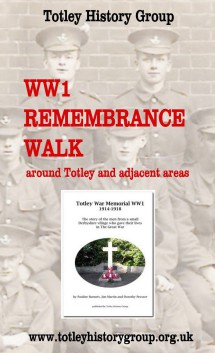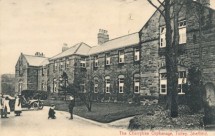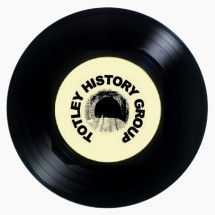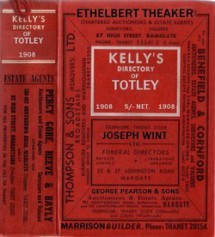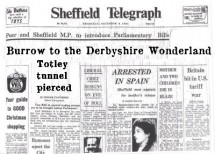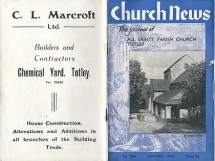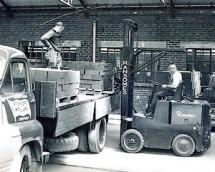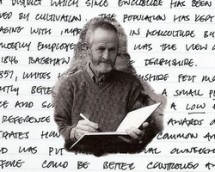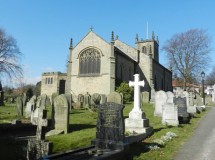The Evans family of Franklin, Warren County, Ohio, USA
When we were transcribing the 1911 Census records for Totley, one of the more intriguing entries was for a family of Americans living at Hill Crest, Baslow Road - the last of the three large houses above the Fleur de Lys. We wanted to know who they were and what became of them. Whilst our research is in its infancy, we thought we would tell you about the progress we have made, partly in the hope that it may interest an American reader who has access to on-line Census, BMD and similar information and who might be able to add to our knowledge.
The head of the household was Dr. Rice Kemper Evans, American Vice and Deputy Consul in Sheffield, who was born on 3 Feb 1879, the son of Dr. Firman Richard Evans and Sallie Fulton Taylor of Franklin, Ohio. Rice Evans's family had been physicians in Franklin continuously since 1827 when his great-grandfather, Dr. Otho Evans, moved his practice there from neighbouring Butler County. His great-great-grandfather, John Noble Cumming Schenck, was the brother of the founder of the town.
Rice Evans had graduated from the Miami Medical College, Cincinnati in 1902 and practised medicine until early 1909 when he entered the diplomatic service and, after declining the position of Vice Consul in Santiago, Cuba, he was appointed by President Taft to a commission in Sheffield on 26 April. Rice Evans had married Louise Dillon Cass (born 1878), daughter of Will Cass and Sarah Shiflett of Blanchester, Ohio on 20 Aug 1900.
They sailed from Philadelphia aboard the Friesland and disembarked at Liverpool on 25 May 1909 accompanied by their four children: Cornelia Sarah (born 5 Sep 1901), Richard Pierce known as Dick (born 29 Aug 1903), Bergen Baldwin (born 19 Sep 1904) and Alyse (born circa 1908). Another daughter, Joan (born 22 Nov 1905) had died in infancy in America in 1906. Cornelia was not present at Hill Crest on census night, 2 Apr 1911, and we are still trying to trace her.
The American Consulate had been established in Sheffield in 1863 and was to continue until 1940. When Rice Evans worked there, it was located in the Fosters Building on High Street, where McDonalds is now. Its main role was to facilitate trade between the two countries and Rice Evans filed a number of reports on the steel and cutlery industries. He also wrote a detailed account of the business transacted by Sheffield's seventeen cinematograph theatres noting that whilst American-made action films, particularly westerns, were very popular the standard of British-made films was very high and their subject matter was more geared to educate and enlighten their audiences. Rice Evans used his spare time to obtain a degree with a first in international law at Sheffield University. He and his family were delighted with England and they made many friends.
The family lived together in Totley until 1915 when Rice Evans’s salary was becoming insufficient to support his large family, daughter Blancet having been born in 1912. With the outbreak of World War I, he decided to send the children back to America to live with their great aunt Cornelia Schenck in Franklin. The passenger register of the Haverford shows that the children, aged between 2 and 13, sailed from Liverpool on 27 Jan 1915 bound for Philadelphia. From there they made their way to the house of their grandparents, completing the entire journey unaccompanied by adults. Their mother never saw them again; she died of tuberculosis at home in Totley on 15 Apr 1917 aged 38. Her remains were cremated and her ashes were sent home to Ohio.
After the war Rice Evans made a ten week visit home to see his family, departing from Liverpool on 7 Mar 1919 aboard the Minnedosa, landing at St. John, New Brunswick. He arrived back in Liverpool on 18 May 1919 having sailed from Montreal on the Metagama and six days later he married, by licence, Dorothy Maud Davis.
Dorothy had been born in Birmingham, Warwickshire, in 1890 the fourth child of William Henry Davis, a wine and spirit merchant from Bury, Lancashire and his Canadian wife Emma Maud Doughty. Dorothy had been trained as a nurse and had worked in children's hospitals. The Butler County Democrat reported that Rice Evans had met his bride while working in the hospital service during the war. Perhaps they met at Totley Bents. Wounded soldiers from the front line in France were brought to a field hospital on the recreation ground adjoining The Cricket Inn. Rice Evans was a frequent visitor and was greatly appreciated for his expertise.
The Democrat was mistaken, however, in reporting that the wedding took place in Sheffield when actually it was at All Saints Parish Church, Trefonen, Shropshire about three miles from the Welsh border. Sensing a story here, we have tried to find out what the connection was between the couple and this small village. By sending for the marriage certificate and with help from the Gateacre Society, we think we have found it.
The bride and groom gave their residence as 'The Old Malthouse, Trefonen' and the witnesses were Dorothy's brothers Leonard and William and also Viva Chapple-Gill. We have been able to trace Leonard Davis in the 1911 Census living with his wife and son in south Liverpool and employed as a chauffeur. The Chapple-Gill family, Liverpool cotton merchants, were living at nearby Gateacre when - as family legend has it - their youngest daughter Viva ran off with the chauffeur to live happily ever after in mid-Wales. The chauffeur's name was not remembered but it was thought that he had a wife. Too much of a coincidence, surely? But why the Welsh Borders? The Gill Family had many connections with Montgomeryshire: family members having been High Sherriff of the county at various times. Whilst Viva remained in the area for the rest of her life, Leonard returned to Liverpool to be reunited with his family.
Kelly's Trade directory for Sheffield & Rotherham had the Evanses living at Hill Crest, Totley in 1925, but Dorothy Evans gave her address as c/o U.S. Consulate, Sheffield, when she sailed alone from Southampton to New York on 31 May 1928 aboard the President Roosevelt. We don't know the details of her husband's departure for home but the Florida Passenger Lists 1898-1963 evidently show his arrival at Key West on 30 Apr 1928.
What we do know is that before he left England, Rice Evans made his mark as a rock climber important enough to be acclaimed in Colin Wells’s book Who’s Who in British Climbing published as recently as 2008. Rice Evans was described as powerfully built with an enormous reach and he was noted for his pleasantness, competence and strength rather than for exceptional skill. He was said to be the undisputed monarch of Stanage Edge, Derbyshire in the 1920s. The Surgeon’s Saunter Area, a high buttress, was named after him by Fred Piggott who is credited with a first ascent of the climb Doctor’s Chimney in 1929. Rice Evans's most enduring contribution to climbing was to invent the expression 'layback' to describe the posture of a climber pulling out on an edge of a crack or flake, with his feet on the opposite wall. The term has since acquired a permanent and international status. A climbing friend said that Rice Evans had an insatiable appetite for the gritstone edge but when the time was approaching to return home to America he became so morose that he would not even talk about climbing any more.
At the time the census was taken on 1 Apr 1930, Rice and Dorothy Evans were living in Dayton, Ohio and they were still living there on 1 Apr 1940 when their occupations were described as personnel directors working in the electrical motors manufacturing industry. Dorothy Evans passed away in 1951 and Rice Evans died in Dayton on 30 Nov 1957. They are buried in the family grave at Woodhill Cemetery, Franklin.
Cornelia Evans studied at Lasell Seminary for Young Women and Wellesley College, both in Massachusetts, and at Columbia University, New York City. She became a writer of articles, essays, short novels such as the prize-winning The Cloud of Witnesses and the dramatization Journey into the Fog: the Story of Vitus Bering and the Bering Sea. In 1930, she married Harry Wright Goodhue and the couple lived in Greenwich Village, New York. Her husband was born in 1905 at Cambridge, Massachusetts, the eldest son of Harry Eldredge (1873-1918) and Mary Louise Wright Goodhue.
Wright, as he was known to distinguish him from his father, became a brilliant stained glass artist who designed and fabricated windows for more than thirty churches and exhibited his work at the Boston Society for Arts and Crafts. Wright Goodhue committed suicide in 1931 at age 26.
Cornelia then had a liaison with folksinger-songwriter Sam Eskin, the son of Morris and Rachel Eskin, who was born on 5 Jul 1898 in Washington, D.C. Their son Otho Evans Eskin was born in New York City in 1935. Otho and Cornelia were living at 64 Horatio Street, New York City when the census was taken on 1 Apr 1940. Cornelia's occupation was recorded as a researcher in the glass manufacturing industry. During the War years she worked with the Red Cross in the writing and editing of pamphlets and brochures and by the 1950s she had become a writing consultant to the Department of Health, Education and Welfare in Washington D.C.
Otho's half-brother Stanley Eskin later described Cornelia as "an unpretty woman but most interesting with a razor-sharp mind and a gift for words". Cornelia lived with Sam for only a brief period and kept their son at a distance from him. Neverless she maintained a cordial relationship with him for the rest of his life which was ended by a sudden heart attack on 7 Sep 1974.
Cornelia returned to Totley around this time to visit the place of her childhood and to reminisce about her family with locals like Dan Reynolds who lived in her old house. Cornelia Cass Evans Goodhue died in 1986.
Dick Evans returned to Sheffield soon after the war ended. Aged 15 he sailed alone from Philadelphia aboard the Northland, docking in Liverpool on 12 Jun 1919. Dick gave his intended address as Totley, Sheffield and his occupation as student.
Dick married Phyllis Helen Swift, the daughter of George Edward Cooper Swift and Caroline Annie Taylor of 619 Abbeydale Road in Sheffield on 5 May 1925. Two days later the couple left Liverpool aboard the Oriana for Havana, Cuba. The passenger register shows the couple's last address as 46 Sandford Grove Road, Sheffield and Dick's occupation as a steelworker.
On 31 Aug 1928 Dick and Phyllis Evans arrived back in Sheffield for a short visit having sailed from Havana to Liverpool aboard the Orbita. The passenger register shows the same Sheffield address as before but Dick's occupation in Cuba had been a fruit farmer. They returned to Havana on the same ship which departed Liverpool on 1 Nov 1928.
The family appeared in the 1930 census in Atlanta, Georgia and the following year they were living in St Louis, Missouri where their son Pierce Firman Taylor Evans was born on 26 Oct. They were still living in St Louis in 1935 when Phyllis and Pierce made a brief visit to England sailing from New York to Liverpool aboard the Laconia. Phyllis gave the current addess of her parents, 10 Edgefield Road, Sheffield.
A daughter, Margaret, was born in Illinois on 27 Apr 1939 and the family of four appeared in the 1940 census for Hasbrough Heights, New Jersey where Dick was employed as a salesman in the steel industry. Phyllis Evans made a further visit to Sheffield in the summer of 1956, arriving on the United States in Southampton on 11 Jul and returning on the same ship on 23 Aug. She was accompanied by her 17 years old daughter Margaret and gave her address as 31 Dover Road, Sheffield. The passenger register on the return voyage recorded Phyllis's occupation as a teacher and Margaret's as a student.
In his Memoirs, Dan Reynolds remembers young Dick Evans as a "real daredevil". Following Cornelia's visit to Totley in 1973, Dan and Dick corresponded for a number of years. In an interview given to the (Sheffield) Morning Telegraph on 15 Nov 1976 Dan said that Dick's letters were full of old Totley memories and photographs of old village properties long since pulled down.
Dick Evans died on 29 Apr 1980 in Hackensack, New Jersey.
Bergen Evans also crossed the Atlantic again, the first time as an 18 year old working his way as a pantry hand on board the Schoharie in the summer of 1923. After schooling in Totley ("a village school that would have appalled Dickens"), Abbeydale and Franklin, he had entered Miami University in Oxford, Ohio at age 15. He graduated in 1924, then earned an M.A. from Harvard in 1925 and went back to Miami University to teach English from 1925 to 1928. Bergen returned to England as a Rhodes Scholar from 1929 to 1931 receiving a B. Litt. from Oxford University in 1930. A Ph.D. in English Philology from Harvard followed in 1932 which made him the 5th generation Dr. Evans but the first not to practice medicine.
In September 1932 Bergen Evans began a teaching career at Northwestern University, Evanston, Illinois and remained there until his retirement in 1974 being promoted to Professor in 1944. His courses were very popular and attracted more students than any other offered by the University. As one former student recalled "His class was an intellectual nirvana. He could make the mustiest, crustiest, dustiest literature as vibrant as hell."
He simultaneously followed a second career as an author, radio and television panel-show host and he also prepared questions and validated answers for the television series $64,000 Question. His scholarly books include A Dictionary of Contemporary American Usage which he co-wrote with his sister Cornelia. The work took seven years to come to publication in 1957. Collaboration between the two siblings was nothing new; it had begun in Totley when the pair had teamed up to write plays and verses for their family's approval.
Bergen Evans also wrote a Dictionary of Quotations (1968) and a Dictionary of Mythology, Mainly Classical (1970). Known for his dry wit and outspoken style, he was a much sought-after speaker and was himself much quoted.
Bergen Evans was a proponent of skeptism: he assumed that everyone was a liar until proven otherwise and he delighted in debunking widely held misconceptions. His best known works were in this field, The Natural History of Nonsense, in 1946 and The Spoor of Spooks and Other Nonsense, in 1954. He had many interesting offers from both academic and commercial organisations including one from Life magazine which offered him a full-time post to edit Winston Churchill’s memoirs.
On 5 Aug 1939, Bergen Evans married Jean Whinery, the daughter of Charles Crawford Whinery, the American editor of the 11th edition of Encyclopaedia Britannica. They had two sons: Derek, born in 1943 and Scott, born in 1945. In their later years they lived on a small farm in Northfield, Illinois where Bergen liked to ride his Harley-Davidson motorcycle.
Bergen Evans died on 4 Feb 1978. He left 83 boxes of material to the Northwestern University Archives containing educational papers, research files, television and radio program files, speeches and correspondence including 13 letters from his friend Groucho Marx who appeared on his television show. Jean Evans died on 9 Jun 2011 aged 99.
Alyse Evans went to school in Franklin and then entered Miami University in Oxford, Ohio in 1925. She made a short visit to England in 1932 arriving from New York on 15 Jul at Southampton on the Majestic and returning from Liverpool on 20 Aug aboard the Baltic. Her occupation was a teacher and her intended address in England was University College, Oxford, the same address as that given by her brother Bergen who had arrived back in England shortly before her on the Ile de France.
Alyse married Leslie John Fahey sometime between 26 Dec 1932, when his first wife Marguerite died, and July 1936 when she visited England with her husband. They lived in Cleveland. Leslie had been a salesman but by this trip he was a manager; Alyse was now a housewife. The couple made a further trip across the Atlantic in 1951 passing through England on their way to the continent. Their return voyage on 15 Jun from Southampton to New York was aboard Cunard's Queen Elizabeth. Leslie Fahey died on 14 Jun 1983 aged 86 and Alyse on 7 Jun 1987 aged 79, both in Cleveland.
Not much reliable information has come to light about Rice and Louise Evans's youngest daughter who was born at Hill Crest in Totley on 1 Sep 1912. The spelling of her forename seems to have caused problems all her life. We have obtained a copy of her birth certificate and, for sure, her father registered the name as Blancet, but it was spelled Blachette on the passenger list when, in 1915, she left Liverpool and Blanchette when she arrived in Philadelphia.
From the family gravestone we can see that Blancett died in 1934, having married a Mr. Raznick. Her obituary appeared on page 63 of the Franklin Chronicle dated 23 Aug 1934 but so far we have been unable to obtain a copy of it. We have managed to trace a marriage in Littleton, Arapahoe County, Colorado to E. E. Raznick (born c. 1902) and Blanchett Evans on 6 Mar 1930.
If you have any more information, or can correct mistakes we have made, we would be delighted to hear from you.
You can email us at contactus@totleyhistorygroup.org.uk.
There is a family tree associated with this article which gives many of the sources of our information.
It is found at: http://trees.ancestry.co.uk/tree/53337809/family
Copies of the following books are available to borrow for members of Totley History Group:
- A Dictionary of Contemporary American Usage by Bergen Evans and Cornelia Evans. Published by Random House, New York. 1957. Seventh Printing
- Dictionary of Quotations Collected and Arranged and with Comments by Bergen Evans. Published by Avenel Books, New York. 1978 Printing.
- The Natural History of Nonsense by Bergen Evans. Published by Michael Joseph Ltd, London. Second Impression, November 1947.
- The Spoor of Spooks and Other Nonsense by Bergen Evans. Published by Alfred A. Knopf, New York. First Edition. 1954
- Who's Who In British Climbing by Colin Wells. Published by The Climbing Company Ltd, Buxton, Derbyshire. First Edition. 2008
- Rock Climbs in the Peak. Volume 1. The Sheffield-Stanage Area. Edited by Eric Byne. Published by Cade & Co (Publications) Ltd. 1963. Contains a photo of Rice Evans leading the Crab Crawl, Stanage Edge, by P.A. Barnes and mention in the bibliography of Rice's own contributions to rock climbing literature.
- Peak Rock. the history, the routes, the climbers. by Phil Kelly, Graham Hoey, Giles Barker et. al. Published by Vertebrate Publishing. 2014 Reprinting. Contains a reproduction of Rice Evans's passport photo and photos on Doctor's Chimney and Manhatten Chimney, Stanage Edge.
Update
In May 2016 we were surprised and delighted to receive correspondence from members of the family of Dr. Rice K. Evans, the American Vice and Deputy Consul in Sheffield, who lived in Totley from 1909 to 1928. Our article on the Evans Family was one of the earliest to appear on our website in the spring of 2013. Brian Duckworth, from West Roxbury, Massachusetts, wrote to say how much he enjoyed reading the article. Brian married Rice's great granddaughter Katherine Evans Eskin. Katherine's sister, Cornelia (Neal), who lives in Munich, had come across the article and mentioned it to other members of the family. Brian's email was followed shortly afterwards by one from the sisters' father, Otho Evans Eskin. Otho has sent us extracts from his memoirs and given us permission to publish them together with several family photographs.
Search Our Website Here
September
October
November
Unless stated otherwise our meetings are held in Totley Library on the 4th Wednesday of each month at 7.30pm.
Pauline Burnett's book The Rise of Totley Rise has been revised and updated. It tells the story of this small piece of land from 1875 when there was only a rolling mill and chemical yard alongside the river a mile from Totley, through Victorian and Edwardian times, two world wars and up to the present day. It has 94 pages including a useful index and many illustrations from private collections. The book is available now from Totley Rise Post Office priced at £5, or through our website when an additional charge will be made to cover packing and postage.
A few copies are still available of Sally Goldsmith's book Thirteen Acres: John Ruskin and the Totley Communists. Totley was the site of a utopian scheme funded by art critic and social reformer John Ruskin. In 1877 he bought 13-acre St. George’s Farm so that nine Sheffield working men and their families could work the land and, to keep themselves busy, make boots and shoes. Sally tells an engaging story from our history with a quirky cast of characters including Ruskin himself, the poet and gay rights activist Edward Carpenter and Henry Swan, a cycling, vegetarian artist and Quaker. The book is available to order online from the The Guild of St. George by following this link.
A recently discovered box of WWII correspondence reveals the story of how a small group of ladies from Dore and Totley recruited knitters from the west of Sheffield and how their efforts made them the country's greatest provider of Comforts for the Minesweeping crews of the Royal Navy. The story is told in Knit For Victory, a new book from Totley History Group. Written by Pauline Burnett, it has 82 pages and many illustrations. It is on sale in local shops and via our website. Further information about the correspondence is in this inside page of our website: Dore & Totley Minesweeping Trawlers Comforts Fund.
The story is told in Totley War Memorial WW1 of the ten men from our village who gave their lives in the Great War. Written by Pauline Burnett, Jim Martin and Dorothy Prosser, a chapter is devoted to each of the soldiers with a family tree followed by as much information as could be discovered about the men and their families. There is also information about their military careers and the actions in which they lost their lives. The book has 64 pages and is illustrated throughout with photographs of the men, their families and the houses where they lived.
Totley All Saints' Church Parish Magazines for the years 1985-2006 with notices of baptisms, marriages and funerals and accounts of spiritual, educational, charitable and social matters in the village. Scanned in full, including advertisements from local traders.
In 1893 during the building of the Totley Tunnel there was an outbreak of smallpox amongst the navvies which spread to some of the local population. 17 people were buried in communal graves in Dore Churchyard, 6 from "Green Oak" (Lemont Road). The severity of the outbreak was principally caused by overcrowding and insanitary conditions in lodging houses .
Kathleen Grayson was a 39 year old housewife when WW2 broke out. She volunteered for the ARP and became an ambulance driver. During an air raid on Sheffield in July 1941, and despite her own injuries, she managed to get a seriously injured casualty to hospital. For this she was awarded a commendation from King George VI. Together with her friend Hilda Duffy, Kathleen also assembled a team of knitters to provide essential warm clothing for the men serving on the minesweepers patrolling the North Sea.
We have recently bought at auction the WW2 memorabilia of Douglas Platts whose family home was at Hillside, 98 Queen Victoria Road. After the war Douglas returned to his civilian occupation working in the family scissors manufacturing business. He lived in our area for the rest of his life.
We are very grateful to Mrs Valerie Taylor of Dore for lending us the title deeds to Lower Bents Farmhouse which is reputed to be the oldest surviving building in the area with a proven history back to 1621. We have now scanned and transcribed the deeds which could be particularly interesting to anyone with a connection to the local Fisher, Dalton and Marshall Families.
Until 1844, when Dore Christ Church parish was created, Totley township was part of Dronfield parish. We have now transcribed the burial records for former Totley residents at St. John the Baptist, Dronfield for the period 1678-1870 and at St. Swithin, Holmesfield for the period 1766-1901.
Whilst researching the history of the Dalton Family we found it useful to transcribe a number of early Wills and Inventories. These and those of many other Totley, Dore and Holmesfield people dating from between 1594 and 1856 have now been added to our website.
St. Swithin's Church, Holmesfield pre-dates Dore Christ Church and was the place where many of the people from Totley worshipped and were baptised, married and buried. Read the inscriptions on more than 750 gravestones in the churchyard including those of Mr. and Mrs. William Aldam Milner of Totley Hall, Jessie Matilda Tyzack (nee Fisher) of Avenue Farm, and Rev. J. A. Kerfoot of St. John's, Abbeydale.
Thomas Youdan was a music hall proprietor and benefactor who was living at Grove House, Totley in 1867 when he sponsored the first football knockout competition in the world for The Youdan Cup.
The words Millhouses Cricket Club can be seen in the background of team photos which are likely to date from between 1905 and the early 1920s, very probably pre-war. They were lent to us by Garth Inman who can identify his great uncle, Cecil Inman, in some of the photos and would like to know when they were taken and, if possible, the names of others present. Please take a look to see whether you can put names to any of the faces.
Josiah Hibberd was seriously injured whilst working on the construction of the Totley Tunnel in 1892. He died on 9 May 1897 at the age of 38 having apparently spent most of previous five years in hospital.
Bradway House was built around 1832 by Henry Greaves, a farmer, together with two adjacent cottages. We have traced most of the occupants of the property from these early days up to the start of World War Two.
We have transcribed the baptisms records at St. John the Evangelist, Abbeydale from when the church was consecrated in 1876 until just after the start of World War 1. The records are arranged in alphabetical order based upon the child's name and show the date of baptism, the names of the parents, their home location and occupation.
Nick Kuhn bought an original 1920s poster which had this owners' blind stamp in one corner. The stamp almost certainly refers to a house named Wigmore that was built in the late 1920s or early 1930s. The first occupiers that we can trace are John Howarth Caine, a district mineral agent for the LNER, his wife Florence Jane (nee Prince) and daughter Doris Mary. The Caine family lived at Wigmore until 1936 by which time the house would have been known simply as 12 The Quandrant.
George Griffiths died on 13 December 1888 following an explosion during the sinking of number 3 airshaft at Totley Bents. His widow Florence died shortly afterwards and his two daughters Maud and Annie were adopted separately. Whilst Annie lived the rest of her life in Yorkshire, Maud emigrated to Australia in 1923 with her husband, John Burrows, daughter Margaret and son Jack, pictured above.
George Wainwright was said to have been born in Bamford, Derbyshire in 1714. He learned the trade of linen weaving and moved to Totley after his marriage on 1744. He became an ardent follower of John Wesley who paid many visits to Sheffield and who would have passed through or close to Totley. Preaching was at first conducted out of doors and when Wesley's preachers became harassed by a mob of Totley ruffians in 1760, George offered them safety of his own home. He remained a Methodist for all of his long life, dying in Dore in 1821 at the reputed age of 107.
Oakwood School was started by Mrs Phoebe Holroyd in 1925 initially as the Firth Park Kindergarten and, by 1927, as the Firth Park Preparatory School. Phoebe was still working at the school almost fifty years later when she was well into her seventies. We would like to hear from anyone with memories of the school.
James Curtis was born at sea aboard HMS Chichester in 1790. He enlisted as a Private in the 1st Grenadier Regiment of Foot Guards in Sheffield in 1812 and served in Spain and Portugal during the Peninsular War. He later fought in France and Belgium taking part in the Battle of Waterloo. In later life James lived at the Cricket Inn where his son-in-law William Anthony was the licensed victualler. He died in Heeley in 1882 aged about 91.
Charles Paul lived in Totley in later life. He was a local historian and archaeologist who was an authority on the history of Sheffield, especially the two areas he knew best: Attercliffe and Ecclesall. His books and letters to local newspapers were published under the Latin form of his name Carolus Paulus.
Towards the end of the 19th century Totley Hall gardens became a well known beauty spot that attracted many hundreds of visitors from Sheffield on open days and the rock gardens became one of its most popular features. Mrs Annie Charlesworth sent us six glass transparencies of the rock gardens taken, we believe, in the early years following the Great War.
Anton Rodgers send us photographs of three water-colours that had been bought by his grandfather at a sale of the contents of Abbeydale Hall in 1919. One was of a scene said to be in York by A. Wilson. A second was of a seated child with a dog believed to be pianted by Juliana Russell (1841-1898). The third was of Lake Como, by Ainslie Hodson Bean (1851-1918) who lived for much of his life on the Riviera and in North Italy.
A Canadian correspondent sent us photographs of a set of silver spoons that were bought in a small town in British Columbia. The case contained a note signed by Ebenezer Hall indicating that they were a wedding gift to Maurice and Fanny Housley. We think we may have traced how they got to Canada and where they might have been since.
Green Oak Park was opened on 23 March 1929 on land that had been bought by Norton District Council from John Thomas Carr, a farmer and smallholder of Mona Villas. In later years, the buildings were used by the Bowling Club (the green having been built in 1956) and by the park keeper. However, the buildings appear to have been constructed in several phases, the oldest of which predates the park to the time when the land was used for pasture.
We believe the old Totley Police Station at 331 Baslow Road was built around 1882. Two lock-up cells were excavated just below floor level in the summer of 1890. We have traced the Derbyshire Constabulary police officers who lived there from John Burford in 1886 to George Thomas Wood who was there when Totley was absorbed into Sheffield in 1934.
David Stanley lived in Totley Rise in the later years of his life. Born in Bulwell, Nottinghamshire, he joined the 17th Lancers when he was 19 and rode in the Charge of The Light Brigade at the Battle of Balaclava where he was seriously wounded. For the first reunion of veterans in 1875, he told his story to a reporter from the Buxton Herald.
This picture postcard was addressed to Miss Abell, Holly Dene, Totley Brook Road and posted in Rotherham on 10 December 1907. Edith Annie Abell was born on 4 February 1887 in Sheffield and her family came to live in our area in the 1900s, staying for the rest of their lives.
Charles Herbert Nunn enlisted in the British Army on 23 August 1915 and was sent to France on 18 December 1915 to served with the British Expeditionary Force. In March 1916 it was discovered that he was underage and he was returned home. Shortly after his 18th birthday he re-enlisted and was again posted abroad where, in addition to this trio of medals, he was awarded the Military Medal.
This certificate was awarded jointly by the Red Cross and St. John's Ambulance to Isaac Henry Williams, of Lemont Road, for his services during WW1 as a stretcher bearer. We are seeking anyone who can help us pass it on to a living relative.
In 1832 Samuel Dean pleaded guilty to stealing a quantity of lead from the Totley Rolling Mill and was sentenced to seven years transportation to Australia. He sailed on the Mangles and upon arrival in New South Wales he was sent to work for William Cox, the famous English explorer and pioneer. After receiving his Certificate of Freedom in 1840, Samuel became a farmer and went on to have a very large family. Samuel was born in Whitechapel around 1811 to parents Samuel Dean Snr. and Susannah Duck. His descendant Sarah Dean would like help in tracing his ancestry.
Ellen Topham was born in 1889 in Nottingham. Her parents had been living together since 1862 but had never married so it was most unusual that, after their deaths, Ellen was accepted into Cherrytree Orphanage. Even more so since her father, Snowden Topham, had been acquitted somewhat unexpectedly in a widely reported manslaughter trial. Ellen remained at Cherrytree until her death from pulmonary tuberculosis at the age of 15.
Mabel Wilkes was a resident in Cherrytree Orphanage between 1897 and 1905. Her granddaughter Sally Knights sent us these images of a book presented to Mabel as a prize for her writing. Sally also sent us some personal memories of her grandmother and a photograph of a locket which contains portraits of Mabel and her husband Septimus Gale.
John Henry Manby Keighley was living at Avenue Farm when he enlisted in 1916. He fought in France with the Cheshire Regiment but after home leave in early 1918 he went missing. The Army were unable to determine whether he had deserted or returned to the front and been either killed or captured by the enemy. In August 1919 he was formally presumed killed in action but it appears he did not die but returned home to his family.
Horace Ford was admitted to Cherrytree Orphanage on 26 October 1888 at the age of six. He left at the age of 14 to become an apprentice blacksmith and farrier. Soon after his 18th birthday Horace enlisted in the Imperial Yeomanry to serve his country in the war in South Africa. His letter home to his Orphanage mentor tells of the lucky escape he had in battle.
Pat Skidmore (née Sampy) lived on Totley Brook Road from 1932 to 1948 before her family moved to Main Avenue. In this short article she remembers her time at Totley All Saints School where she was a contemporary of Eric Renshaw and Bob Carr.
As we have nowhere to exhibit memorabilia and artifacts, we have created a Virtual Museum instead. The latest addition to our collection is this double-sided Totley Rise Post Office oval illuminated sign which was on the wall of 67 Baslow Road before the Post Office business transferred to number 71. Please contact us by email if you have things that you own and would like to see added to the virtual museum.
Conway Plumbe was a man of many talents who came to live in Totley Rise around 1912. As a young man he had poems published by Punch magazine and is remembered in modern collections of WW1 poetry. A number of his paintings were accepted by the Royal Academy. An engineering graduate of London University, he joined the Civil Service where he rose to a high level as a factory inspector, publishing two books on the subject and giving a series of talks on workplace health and safety on BBC radio during WW2. In retirement he wrote a philosophical-spiritual work called Release From Time.
Inside Totley Rise Methodist Church there is a Roll of Honour commemorating the soldiers from its congregation who served their king and country during the Great War. For all but one of the 28 names the soldier's regiment is recorded in the next column. The exception is David Cockshott for whom 'killed in action' is written alongside yet he appears on no war memorial in our area and no record of a mortally wounded soldier of that name is to be found. We think we have solved the mystery.
Mrs. Kate Plumbe moved from Mansfield to Totley Rise with a number of her family in 1913 and became closely involved with the Totley Union Church. Her daughter Winifred became a missionary and headmistress in Calcutta for over 38 years following which she returned home to live with her sister Hilda on Furniss Avenue. Hilda had also been a teacher, missionary and, like her mother, a volunteer at St. John's VAD during WW1.
Thomas Glossop was a cutler and razor manufacturer who was well known amongst cricketing and gardening circles. Despite going blind, he was able to continue his hobbies with remarkable success
The Totley Union Cycling Society Prize Giving and Fete was held on the fields near Abbeydale Hall on 18 July 1914. Anne Rafferty and Gordon Wainwright have named some of the people in two wonderful photographs of the event. Can you identify any more for us?
The Tyzack family are well known in our area for owning iron and steel trades at Walk Mill, Abbeydale Works, Totley Rolling Mill and Totley Forge. This article covers the history of the family from the late 18th century when William Tyzack the founder of the company was born until the early 20th century when Joshua Tyzack farmed at Avenue Farm, Dore.
Walter Waller Marrison moved to Totley around 1897 with his wife and their two young sons. He was a house builder who constructed properties around Totley Brook and Greenoak before ill health forced him to take up less physically demanding work. In 1904 he took over the tenancy of the grocers and off licence at number 71 Baslow Road. After his death in 1908, his widow Kate and later their eldest son Jack continued to run the business until it was sold in 1934.
Ron Wijk of Nieuw-Vennep in the Netherlands has sent us two scanned images of drawings of old cottages made by the celebrated Dutch painter, Anton Pieck (1895-1987) simply annotated "Totley", and wondered whether we could identify their locations.
We would like to thank Christopher Rodgers for bringing to our attention this fascinating log of the 85th Sheffield (St. John's and Totley Orphanage) Wolf Cub Pack for 1927-45. The log is published jointly by Sheffield Scout Archives and Totley History Group as a free PDF download. It is illustrated by no fewer than 92 photographs and is supported by a comprehensive index and biographies of some of the main participants.
Following our Open Meeting event on School Days, Roger Hart, Howard Adams and John Timperley have each written to us with their memories of Norwood School, which was located in the rooms attached to the Dore & Totley United Reformed Church on Totley Brook Road.
On 22nd July 1909 the children of Dore and Totley Schools celebrated by a pageant the union of England under King Ecgbert which took place at Dore in AD 827. The pageant was devised and written by Mrs Sarah Milner and her daughter Marjorie and performed in a field close to Avenue Farm in front of a large audience. Photographs of the event survive together with a fragment of the script.
John Edward Greenwood Pinder had lived all 46 years of his life in Totley but on census night, Sunday 2 April 1911, he was not at home; he was in Derby Gaol serving a sentence of three months hard labour. From the age of 20, John had been in and out of local courts for a series of minor offences including drunkenness, assault, wilful damage and night poaching. Finally he was sent to gaol for cutting down and stealing 86 small trees which he sold in Sheffield market for Christmas.
We have already transcribed the census returns for Totley, Totley Rise and Dore. Now we have transcribed Census Strays. These are people who were born in Totley but are missing from our earlier transcriptions. They may have been living, working or studying elsewhere or just away from home on the night the census was taken. Two people were in prison. Others were in Union Workhouses, hospitals and asylums. Fully indexed strays from the 1851, 1861, 1881, 1891, 1901 and 1911 censuses are available now.
We wish to thank Gillian Walker for allowing us to digitize an archive of material about the 1st Totley Scout Group. Most of the material was collected by Arthur Percival Birley in the period 1949-51 and there are many interesting documents pertaining to the building of the scout hut on Totley Hall Lane. In addition four Newsletters survive, two from the 1940s and two from 1971.
We are grateful to Angela Waite and All Saints' Parish Church for giving us access to baptismal and kindergarten birthday rolls dating from 1926 to 1941. We have transcribed the names, addresses, birthdates and baptismal dates and created an alphabetical index of entries for you to search.
Edmund Sanderson, a Sheffield estate agent, aquired the land on either side of the old drive to Totley Grove in 1874 and divided it into plots for development. He called it the Totley Brook Estate. But before many houses were built, the estate road was severed in two by the building of the Dore & Chinley Railway line. The eastern end of the road became the cul-de-sac we now call Grove Road.
John Roberts was born in Sheffield in 1798. He became a partner in one of the leading silversmiths firms in the city before moving to Abbeydale Park in 1851 and extending the house in Victorian gothic style. He paid for the building of St. John's Church and was believed to dispense more in charity than any other person in the neighbourhood including his protege Ebenezer Hall.
The Coke Family owned the Totley Hall Estate from 1791 to 1881. With the aid of a family tree to guide us, Josie Dunsmore takes us through the story of their tenure.
When the Rev. D'Ewes Coke inherited the Totley Hall Estate in 1791 it had two farms. Josie Dunsmore tells the story of how the two farms were combined under the tenancy of Peter Flint with the aid of field maps drawn by Flint himself and later by the Fairbanks family.
Do you think you recognize this face? More than sixty photographs of the girls and teachers at Hurlfield Grammar School for Girls in the 1940s were given to Totley History Group by Avril Critchley, who was herself a student at the school. The collection includes fifteen form photographs from June 1949. There would have been a number of girls from the Totley area attending the school in those days.
Christine Weaving tells the story of her 2 x great uncle George Edward Hukin, a Totley razor-grinder, and his life-long friendship with the academic, poet, writer, and free-thinker Edward Carpenter.
Eric Renshaw (pictured here on the right with Bob Carr) grew up and lived in Totley from 1932 to 1960. Many of his memories are of a sporting nature.
We are very grateful to Gordon Grayson for giving us this splendid sale document for the Norton Hall Estates, following the death in 1850 of Samuel Shore. The estates included a large part of Totley and the document has maps and illustrations, plus schedules of land and property with the names of tenants. We have also added a transcription of the entries for Totley and Dore.
Watch this Youtube video of the talk given by Dr. Mark Frost and Sally Goldsmith on Ruskin, Totley and St. George's Farm. The talk was hosted by Totley History Group on 20th May 2015 as part of the Ruskin in Sheffield programme. Also enjoy a video of the outdoor performance Boots, Fresh Air & Ginger Beer written by Sally.
When Jacqueline A. Gibbons became interested in what made her father tick, it began a journey through WW1 archive records and led to her flying from Toronto to visit the house and village where he lived and the countryside that he so much enjoyed. Jacqueline reminds us that in the early 20th century Sheffield was a driving force of industry and that Totley was the place where many of its remarkable people lived and where they formulated their ideas.
Edgar Wood was the designer of The Dingle, 172 Prospect Road, built in 1904 for Rev. William Blackshaw, the founder of the Croft House Settlement. The house, together with its western terrace and boundary walls, has now been awarded Grade II listed building status.
What was probably "the most perfect little garden railway in existence" in 1910 was to be found in the grounds of Brook House, Grove Road, the home of its designer and constructor, Guy Mitchell. Look at some wonderful photographs and read reports in newspapers and a full appreciation in Model Railways magazine.
We have now completed our transcription of Totley School's Admission Records for the period from 1877 to 1914. There is also a useful index to the names of the scholars and to their parents or guardians. We are very grateful to Sheffield Archives and Local Studies Library for allowing us to transcribe and publish these records and for permission to reproduce the photograph of a specimen page of the register.
On 8, 9 and 11 November 2014 Totley History Group held an exhibition at Dore & Totley United Reformed Church to commemorate the centenary of the First World War. Below are additional links to some of the photographs we were lent and stories we researched especially for the exhibition.
Oscar Creswick was a local farmer who served with the Army Service Corps in Salonika and who after the war returned to Totley to become the innkeeper of the Cricket Inn and a member of the village's successful tug of war team.
Walter Evans was a market gardener who also ran a small grocery shop on Hillfoot Road when war broke out. He fought with the Machine Gun Corps at the fourth battle of Ypres. After the war, Walter ran a grocers shop at the top of Main Avenue.
Fred Cartwright was another Totley soldier who survived the Great War. He fought in France and Belgium and although he wasn't wounded he was gassed and was home on sick leave when his daughter was delivered by Nurse Jessop during a snowstorm in January 1917.
Maurice Johnson joined the Yorkshire Dragoons, a territorial unit, on 1 Jan 1914 and so was called up at the very start of the war. He fought throughout the war on the Somme, at Ypres and at Cambrai. After demobilization in 1919 Maurice returned to his old occupation in the steel industry.
Bill Glossop lent us a letter written by his father, William Walton Glossop to his wife describing life in the army during training in the north east of England and asking her to keep him in mind with the children.
The photo above provides a link to an album of photographs taken of WW1 Hospitals at St. John's, Abbeydale and the Longshaw Estate.
Nora Green, of Chapel Lane, was only 14 when war broke out. In 1914 she was ill with diphtheria and was sent to the isolation hospital at Holmley Lane, Dronfield. Nora recovered and wrote a letter of thanks to one of the hospital staff and the reply she received survives.
We have collected together on this page the names of local men who appear on various War Memorials and Rolls of Honour in Totley, Dore, Abbeydale, Norton, Holmesfield and Dronfield.
Unfortunately we were unable to identify all the photographs we were lent of Totley Soldiers. Please take a look at this album to see if you recognize any of the missing names.
This walk visits locations that have strong associations with Totley during the First World War. It includes the homes of the ten soldiers from the village who lost their lives, the auxiliary hospitals, war memorials, and even the rifle range on which the soldiers trained. Take a look at the first draft of a new walk by the authors of "Totley War Memorial WW1 1914-1918"
We wish to thank the Trustees of Cherrytree for giving us permission to publish transcriptions of the Cherrytree Orphanage Admissions Book entries for the years 1866-1929. There is also an alphabetical index for you to look at.
With more people having access to faster broadband and mobile networks, we have uploaded seven full and unedited oral history recordings and also added more short excerpts for you to listen to.
Our transcriptions of local trade directories have been expanded to cover the 95 years from 1837-1932 and have also been indexed. From the days when there were a handful of farmers, stone masons, saw handle makers & scythe grinders to the wonders of the Totley Bridge Garage Company, Betty's Boudoir and The Heatherfield Shopping Centre.
We continue to add to our Totley Newspaper Archive. Recent entries have included several about The Plumbe Family, Thomas Glossop and accidents during the construction of Totley Tunnel.
Totley Church of England Parish Magazines for the years 1922-1939 and 1948-1967 with notices of births, marriages and deaths and accounts of spiritual, educational, charitable and social matters in the village.
Around 90 photographs taken by Stuart Greenhoff for his thesis A Geographical Study of Dore and Totley including several of Totley Moor Brickworks. Superb!
Chronologically ordered snippets of information recorded by Brian Edwards during his many years of research into our local history.
Read the inscriptions on more than 700 gravestones in the churchyard.
Visitors since 24 Sep 2012:



